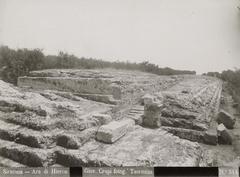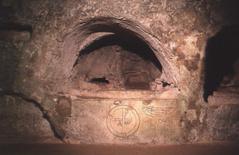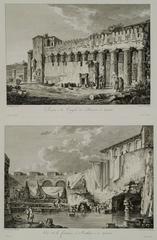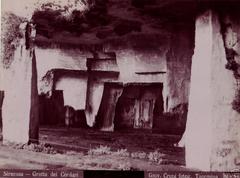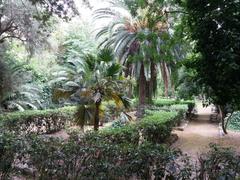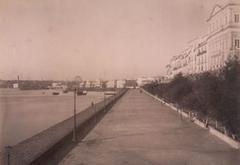Castello Maniace Visiting Hours, Tickets, and Syracuse Historical Sites Guide
Date: 15/06/2025
Introduction
Castello Maniace, set at the southern tip of Ortigia Island in Syracuse, Sicily, is a formidable symbol of the island’s layered history and architectural excellence. Built under Emperor Frederick II in the 13th century, it has played a central role in the defense, governance, and cultural life of Syracuse through the centuries. This guide provides everything you need to plan your visit, from opening hours and ticketing to architectural highlights, accessibility, and tips for making the most of your time in Syracuse.
Table of Contents
- Introduction
- Historical Overview
- Architectural Features
- Visitor Information
- Frequently Asked Questions (FAQ)
- Conclusion
- References and Official Sources
Historical Overview
Origins and Construction
Castello Maniace owes its name to the Byzantine general George Maniakes, who recaptured Syracuse in 1038. However, the current fortress dates to the early 13th century, commissioned by Emperor Frederick II of Hohenstaufen and designed by Riccardo da Lentini. Its strategic location at the tip of Ortigia allowed for control of Syracuse’s harbor and provided a defensive stronghold against potential maritime threats (ilturista.info, siracusaculture.com).
Historical Roles and Transformations
Over the centuries, Castello Maniace has served as a royal residence, military garrison, and prison. Its robust design saw enhancements during Spanish and Bourbon rule, especially as artillery technology advanced. In the 16th century, new bastions and batteries were added to adapt to changing military needs; the castle remained an active military installation until 1972 (sicilydiscovery.com).
Political and Cultural Significance
The castle was not only a defensive bastion but also a center of power. Frederick II signed the foundation of the University of Naples here, and it hosted important events such as the Sicilian Parliament in 1321. Its grand halls and imposing architecture reflect its dual purpose as both fortress and imperial residence (siracusaculture.com).
Architectural Features
Strategic Location and Layout
Castello Maniace sits on a square plan, approximately 51 meters per side, with four cylindrical corner towers. Its location at the tip of Ortigia offers commanding views over the Ionian Sea and the Gulf of Syracuse, controlling access to the harbor and city (Live the World).
Monumental Entrance Portal
The castle’s entrance is a marble portal adorned with intricate carvings, including the coat of arms of Charles V and a mix of animal and vegetal motifs, demonstrating a blend of Norman, Byzantine, and Islamic influences (theworldofsicily.com).
Defensive Features
The fortress features massive limestone walls up to 3.5 meters thick, a moat (now filled), machicolations, arrow slits, and robust corner towers designed to resist both siege engines and artillery fire.
Interior Spaces
The main hall, originally supported by 16 columns and ribbed vaults, once hosted royal gatherings and administrative functions. Though partially destroyed in a 1704 explosion, remaining structures convey its medieval grandeur. The Vignazza battery, a 19th-century addition, further strengthened its seaward defenses.
Visitor Information
Opening Hours
- Standard Hours: Typically, 8:30 AM – 1:30 PM (last entry 12:45 PM)
- Extended Hours: During high season or special events, open until 7:00 PM (last entry 6:15 PM)
- Closed: Mondays and some public holidays
- Check for updates: Official Comune di Siracusa website
Tickets and Admission
- Standard Ticket: €5 for adults
- Reduced: Discounts for students, seniors, and EU citizens aged 18–25
- Free Entry: Children under 18, Syracuse residents, and on select cultural days (e.g., March 8, March 10)
- Purchase: Tickets at the entrance; currently, no online booking for individuals (comune.siracusa.it)
Accessibility
- Partial accessibility: The main courtyard and ground floors are accessible; upper levels and towers require stairs.
- No elevators/ramps to higher sections.
- Contact ahead for specific access needs.
Tours and Events
- Guided Tours: Occasionally available, especially for groups or during high season (catisoutoftheoffice.com).
- Audio Guides: Not currently offered.
- Events: The castle hosts art exhibitions, concerts, and special cultural events, especially in summer (worldcitytrail.com).
Facilities and Tips
- No café or shop on site; bring water, especially in summer.
- Restrooms near the entrance.
- Interpretation: Limited signage; research before visiting or consider hiring a local guide.
- Photography: Allowed in exterior and courtyard areas; restrictions may apply during events.
- Language: Staff speak Italian, with limited English; bring a translation app if needed.
Getting There
- On foot: A 15–20 minute walk from Piazza Duomo along scenic seafront promenades.
- By public transport: Buses and taxis connect central Syracuse to Ortigia.
- Parking: Limited near the Ortigia entrance, especially in peak season (catisoutoftheoffice.com).
Practical Tips
- Best time to visit: Early morning or late afternoon for fewer crowds and cooler temperatures.
- Duration: Allocate 45–90 minutes to explore.
- What to bring: Comfortable shoes, sun protection, and water.
Highlights and Must-See Features
- Marble Entrance Portal: Admire the intricately carved marble featuring animal motifs and heraldic symbols.
- Courtyard: Offers panoramic views of the sea and city.
- Towers: Four circular towers define the castle’s silhouette.
- Great Hall: Remnants of the grand hall with columns and vaults.
- Vignazza Battery: 19th-century addition at the seaward tip.
- Seafront Views: Breathtaking panoramas, especially at sunset (worldcitytrail.com).
Nearby Attractions
Enhance your visit with other historic sites in Ortigia and Syracuse:
- Cathedral of Syracuse: Sicilian Baroque masterpiece (bellaitalytravel.com).
- Fountain of Arethusa: Mythic freshwater spring.
- Bellomo Palace Regional Gallery: Medieval and Renaissance art.
- Archaeological Park of Neapolis: Greek Theater and Roman Amphitheater (Travel Notes and Beyond).
Frequently Asked Questions (FAQ)
Q: What are the current opening hours?
A: Standard hours are 8:30 AM–1:30 PM; extended hours possible during high season. Closed on Mondays (comune.siracusa.it).
Q: How much are tickets?
A: €5 for adults; reduced and free entry available for eligible groups.
Q: Can I buy tickets online?
A: No, tickets are sold at the entrance.
Q: Is Castello Maniace wheelchair accessible?
A: The main courtyard is accessible; upper floors and towers are not.
Q: Are guided tours available?
A: Occasionally, especially for groups or during high season.
Q: Can I take photos?
A: Yes, in exterior and courtyard areas; some restrictions during events.
Q: Are there nearby attractions?
A: Yes—Cathedral of Syracuse, Fountain of Arethusa, Bellomo Palace, and the Archaeological Park.
Conclusion
Castello Maniace is a highlight of any visit to Syracuse and Ortigia, offering a blend of medieval military ingenuity, imperial artistry, and breathtaking seascapes. From its strategic origins under Frederick II to modern restoration efforts, the castle remains a living monument that continues to inspire and educate. Combine your visit with nearby attractions, and be sure to check the latest information on opening hours and cultural events. For a richer experience, use the Audiala app for digital guides and travel tips.
References and Official Sources
- Castello Maniace: A Complete Visitor’s Guide to Syracuse’s Iconic Medieval Fortress (ilturista.info)
- Castello Maniace Visiting Hours, Tickets, and History of Syracuse’s Iconic Castle (siracusaculture.com)
- Visiting Castello Maniace: Hours, Tickets, History & Tips for Syracuse’s Iconic Fortress (comune.siracusa.it)
- Castello Maniace: Visiting Hours, Tickets, and Architectural Highlights in Syracuse (Live the World)
- Visiting Castello Maniace: Hours, Tickets, History & Tips for Syracuse’s Iconic Fortress (catisoutoftheoffice.com)
- Castello Maniace in Syracuse (worldcitytrail.com)
- Sights of Siracusa: Maniace Castle (theworldofsicily.com)
- The Magnificent History of Syracuse’s Castello Maniace in Sicily (bellaitalytravel.com)
- Siracusa Sicily: Ortigia Island and Archaeological Park (Travel Notes and Beyond)
